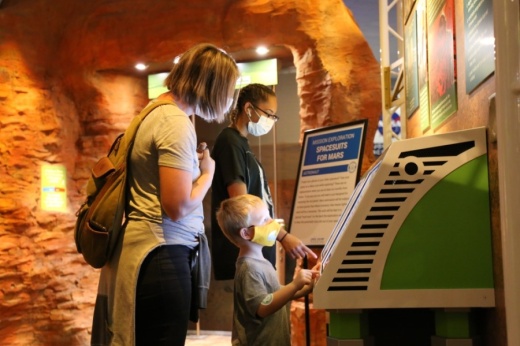“We redesigned the guest experience while we were closed,” Chief Operating Officer Mary Baerg said. “We were busy.”
The first difference is noticeable before even stepping inside. Outside, there is a concierge desk where staff members check bags and give guests reminders before taking souvenir photos, said Meridyth Moore, communications supervisor for the museum.
Inside, the traditional turnstiles guests would use to enter the museum have been replaced with touchless ones. Guests can scan bar codes on their phones for the turnstile to allow them inside, which minimizes contact with surfaces, Moore said.
Normally, the center plaza of Space Center Houston would host an exhibit that is cycled out every few months. Staff has retired such exhibits for the time being, giving guests more space to move.
“You normally have seen a lot of high-touch ... exhibits,” Moore said. “In our closure, we decided to remove and not have the summer one be installed.”
The remaining exhibits have one-way entrances and exits, and floor markings of astronaut footprints remind guests to stay 6 feet apart when waiting in lines.
A popular part of the museum is its tram rides taking guests to nearby Rocket Park, which has a Saturn V rocket, and the Johnson Space Center to see Mission Control and other locations NASA employees use. Johnson Space Center is closed to visitors for the time being, but guests can still ride to Rocket Park, Moore said.
The COVID-19 pandemic allowed museum staff to streamline the tram experience. Normally, guests would have to wait in long lines to board the tram for a visit to Rocket Park or Johnson Space Center. Now, guests sign up for a specific time to ride the tram and are notified on their phones when their tram is boarding, allowing guests more time to peruse the museum, Moore said.
The museum is limited to 25% capacity, and guests must sign up for a specific time to come to the museum so not everyone shows up at once, Moore said.
Many innovations were planned before COVID-19 and expedited due to the pandemic. Others were born from needs the pandemic created, Moore said.
“It’s really been ... a time where we decided we had to make the best out of these situations,” she said.





